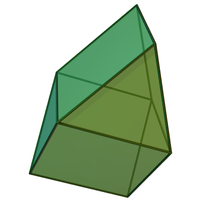Gyrobifastigium
| Gyrobifastigium | |
|---|---|
 |
|
| Type |
Johnson J25 - J26 - J27 |
| Faces | 4 triangles 4 squares |
| Edges | 14 |
| Vertices | 8 |
| Vertex configuration | 4(3.42) 4(3.4.3.4) |
| Symmetry group | D2d |
| Dual polyhedron | - |
| Properties | convex, honeycomb |
| Net | |
 |
|
In geometry, the gyrobifastigium is the 26th Johnson solid (J26). It can be constructed by joining two face-regular triangular prisms along corresponding square faces, giving a quarter-turn to one prism. It is the only Johnson solid that can tile three-dimensional space.
A Johnson solid is one of 92 strictly convex polyhedra that have regular faces but are not uniform (that is, they are not Platonic solids, Archimedean solids, prisms or antiprisms). They were named by Norman Johnson, who first listed these polyhedra in 1966.
The name of the gyrobifastigium comes from the Latin fastigium, meaning a sloping roof. In the standard naming convention of the Johnson solids, bi- means two solids connected at their bases, and gyro- means the two halves are twisted with respect to each other.
The gyrobifastigium's place in the list of Johnson solids, immediately before the bicupolas, is explained by viewing it as a digonal gyrobicupola. Just as the other regular cupolas have an alternating sequence of squares and triangles surrounding a single polygon at the top (triangle, square or pentagon), each half of the gyrobifastigium consists of just alternating squares and triangles, connected at the top only by a ridge.
The gyrated triangular prismatic honeycomb can be constructed by packing together large numbers of identical gyrobifastigiums. The gyrobifastigium is one of five convex polyhedra with regular faces capable of space-filling (the others being the cube, truncated octahedron, triangular and hexagonal prism) and it is the only Johnson solid capable of doing so.
...
Wikipedia
